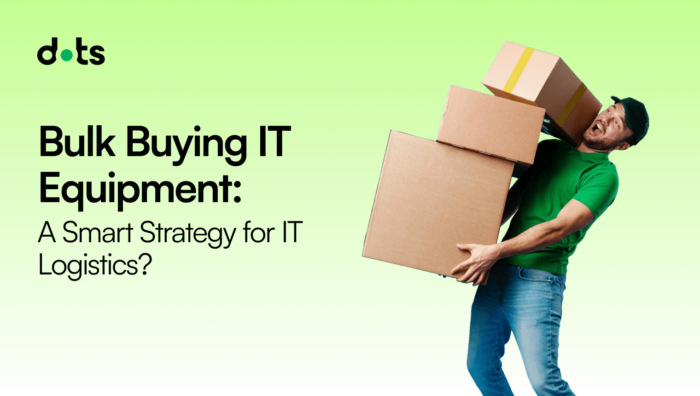Did you know that 82% of organizations allow employees to use personal devices for work? Bring-your-own-device (BYOD) might sound convenient, but data loss remains the top security risk that comes with it. It’s as if sensitive company information is walking out the door, literally.
A controlled approach to IT infrastructure management still does better when it comes to keeping sensitive information safe and reducing tech headaches.
But the problem is that rolling out new IT equipment isn’t as simple as unboxing laptops and handing them out. There’s a lot that goes into it, and if done poorly, you’ll end up with frustrated employees, wasted spend, and IT teams ready to quit.
So, how do you pull off a smooth IT hardware rollout without the chaos? Let’s break it down.
What Actually Happens During an IT Hardware Rollout?
An IT hardware rollout might look like a glorified unboxing session from the outside. Inside the trenches, though, it’s a high-stakes coordination effort that affects your people, processes, and platforms.
Here’s what typically happens behind the scenes:
- Procurement of new IT equipment
- Configuration of devices to meet company specs, including software installs and security settings
- Asset tagging and registration for IT asset management (ITAM) purposes.
- Packaging and shipping (or onsite delivery)
- Installation and setup
- Documentation for compliance and audit readiness
- Remote onboarding support
Now, let’s talk about how to make sure it all goes as smoothly as possible.
Make It a Rollout Worth Talking About
The start of an IT hardware rollout is a golden opportunity to energize your teams.
The goal? Turn “Ugh, new device setup day” into “Yes! My new setup is finally here.”
You don’t need confetti cannons, but a little internal buzz goes a long way. Here are some ideas to hype it up while keeping it real:
- Send preview emails with rollout dates, what to expect, and photos of the gear.
- Drop a Slack or Teams message with a sneak peek and instructions—bonus points if it’s funny.
- Create a simple FAQ so users know how to get help if something doesn’t work right away.
People want to know what’s coming and why it matters. If they feel involved instead of blindsided, you’re already winning.
Communicate… And Then Communicate Some More
IT teams tend to get busy fast. When hardware rollouts kick off, things get louder, messier, and more urgent by the hour. Here, communication is part of your survival strategy.
Clear, proactive messaging can save you hours (or days) of back-and-forth. Here are some communication tips that actually work:
- Start early: Give users lead time to prepare, especially remote workers who may need to update delivery info or clear time for setup.
- Give progress updates: “Your device is being configured” or “Your shipment’s on the way” are small messages that go a long way.
- Use multiple channels: Email is good, but a well-timed calendar invite or automated message via your helpdesk system ensures it gets seen.
Think Past Day One: Maintenance Isn’t an Afterthought
The hardware rollout is just the beginning. What happens next—support, troubleshooting, replacements—can make or break the whole experience. A good rollout includes a long-term strategy that makes maintenance and upgrades feel less like firefighting and more like routine check-ins.
Start by creating a schedule for updates and refresh cycles. Don’t wait for hardware to break down mid-project. You can also use asset lifecycle management tools to track each device from delivery to retirement.
Don’t Wing It: Use IT Asset Management Software
Rolling out IT equipment across a growing team (or across time zones) isn’t something that can live in a spreadsheet.
It’s one thing to track ten laptops. It’s another thing entirely when you’re dealing with hundreds of devices across departments, buildings, or countries.
That’s where ITAM software comes in handy. It gives you visibility, control, and a lot fewer surprises.
What ITAM Software Actually Helps With
You’re not just tracking serial numbers. You’re overseeing a living, breathing system of people and devices that need to work well together. Here’s what a good ITAM platform handles:
- IT hardware procurement and vendor coordination; no more copy-pasting quotes and juggling orders across emails.
- Delivery and logistics tracking, whether it’s one laptop to Boston or 50 workstations to Berlin.
- Onboarding and offboarding processes that don’t rely on someone remembering to collect gear or shut off access.
- Inventory management, including what’s in use, in storage, or due for retirement.
The goal? Make your rollout part of an actual system that evolves with your company.
Don’t Just Roll Out: Review, Improve, Repeat
It’s tempting to close the laptop and breathe a sigh of relief the moment the last device gets delivered and turned on. But if no one ever checks how the rollout actually went, you’re bound to make mistakes on the next one.
A solid IT hardware rollout isn’t complete without feedback and a little self-reflection (yes, even for IT teams).
Look back so you can move forward smarter. Here’s what’s worth evaluating and some questions to ask:
- Deployment speed: Did shipments arrive on time?
- User satisfaction: Did people get what they expected?
- Internal workload: Did the rollout overload your IT staff?
- The accuracy of asset tracking: Are all devices properly logged in your system with the correct user assignments?
Even a short survey or internal debrief can reveal valuable insights. And if users know you actually want their input, they’re more likely to speak up (and less likely to rage-type into your helpdesk portal).
IT Burnout Is Real: Don’t Let Rollouts Add Fuel to the Fire
IT professionals already juggle everything from cybersecurity risks to printer meltdowns, so hardware deployment shouldn’t be another full-time job stacked on top.
Want to ensure your team has the tools and support they need to focus on what matters most? Dots offers ITAM, procurement, warehousing, delivery, and even end-to-end onboarding and offboarding.
Let our platform do the heavy lifting and make Dots your autopilot for logistics. Contact us today for a demo.




